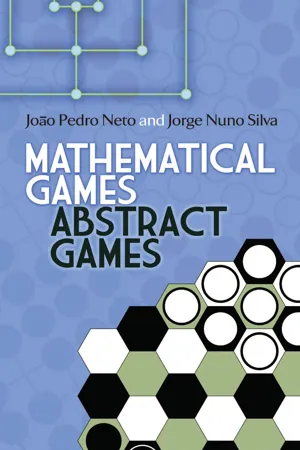
This is a test
- 224 pages
- English
- ePUB (mobile friendly)
- Available on iOS & Android
eBook - ePub
Mathematical Games, Abstract Games
Book details
Book preview
Table of contents
Citations
About This Book
Perfect for those who enjoy intellectual challenges, this user-friendly and visually appealing collection offers both new and classic strategic board games. Chapters include two- and three-player games, a selection of mathematical games that features Nim and games on graphs, a survey of the theory and history of board games, and a lengthy glossary.
Frequently asked questions
At the moment all of our mobile-responsive ePub books are available to download via the app. Most of our PDFs are also available to download and we're working on making the final remaining ones downloadable now. Learn more here.
Both plans give you full access to the library and all of Perlego’s features. The only differences are the price and subscription period: With the annual plan you’ll save around 30% compared to 12 months on the monthly plan.
We are an online textbook subscription service, where you can get access to an entire online library for less than the price of a single book per month. With over 1 million books across 1000+ topics, we’ve got you covered! Learn more here.
Look out for the read-aloud symbol on your next book to see if you can listen to it. The read-aloud tool reads text aloud for you, highlighting the text as it is being read. You can pause it, speed it up and slow it down. Learn more here.
Yes, you can access Mathematical Games, Abstract Games by Joao Pedro Neto, Jorge Nuno Silva in PDF and/or ePUB format, as well as other popular books in Mathematics & Games in Mathematics. We have over one million books available in our catalogue for you to explore.
Information
Chapter 1
The World of Games
Playing is an activity as old as civilization. There are two usual meanings for the word play: any childish activity without rules, and game playing, where rules are essential. This book is about games.
Some games are thousands of years old; they were probably the first strictly mental activities created by man. Nowadays, we learn about old games mainly when they are related to recreational mathematics. An example is Mancala, which uses a board reminiscent of an abacus, an old calculation device.
It is natural to classify games according to their rules. This book does not deal with games where chance plays a role (with the use of dice, for instance), or where there is some hidden information that a player has and his adversary does not (like most card games). Games that avoid these two situations are usually called abstract games.
We do not intend to write down the rules of chess or checkers. Our goal is to present a set of games, some not yet ten years old, that can help the reader and his family and friends find a leisure activity, especially those who enjoy intellectual challenges. Almost all the games treated here (the main exceptions are Go and Hex) have not yet been explored, but were chosen because the authors found in them strategical or tactical qualities, enough to offer hours of ludic pleasure.
We tried to produce a visually appealing and user friendly text, inviting the readers to play abstract games. Some more serious analysis is encouraged, for the enthusiasts.
When learning a game, it is strongly suggested that board and pieces be brought in place and the moves played out. Otherwise, it is easy to misunderstand some part of the rules or other aspects of the games. The authors are available for any clarification, mainly by e-mail.
This book is divided in the following parts:
1) This chapter, which consists of an introduction, an historical survey, and a superficial description of the actual panorama of board games.
2) A section dedicated to games for two players. For each of them, we describe the rules, the necessary material, and make some strategical and tactical commentaries on some positions.
3) A full chapter is occupied with the introduction of a class of mathematical games, which can be, at least in principle, completely analyzed in a quick and efficient manner. Nim and games on graphs are two such examples.
4) A section on games for three players. We present a set of games fit for the occasion when three people want to play and nobody wants to be left out. When the number of players is larger than two, new social complexities arise, such as alliances, diplomacy, threats, and bluffs. A good game for these situations should be interesting without promoting personality clashes or extra-game arguments.
5) A glossary, to help minimize the ambiguity of the rules. It also explains the notations we use throughout the book for boards, positions and moves.
Brief Historical Journey
The expression “mathematical game” can be used to refer to a game, to a puzzle or to a problem of any degree of difficulty. The history of mathematics shows that mathematicians of all ages dedicated some of their energies to activities that could be classified as games. Some fields of mathematics were born this way.
All civilizations produce and play games. We do not know why, but their cultural and educational relevance is clear.
The games we’ll be treating in this book are usually called abstract or mathematical games, but sometimes also games of strategy. We need some boards, that we’ll describe, but in some cases pencil and paper, or piles of beans, are enough to play them.
The oldest game for which we know the rules is the Royal Game of Ur, from Babylon. It was found in the 1920s, and it is just a race between two opponents.

Two sets of pieces and a set of tetrahedrical dice can be seen here.
We think that the pieces used to move in the directions illustrated on the next page, being the length of each dispacement decided by the throwing of the dice.
The first player to finish his course would be the winner.

In ancient Egypt’s tombs, as in the Book of Dead, we can find references to game playing, as can be seen in the picture below, from an inscription found in Nefertari’s tomb:
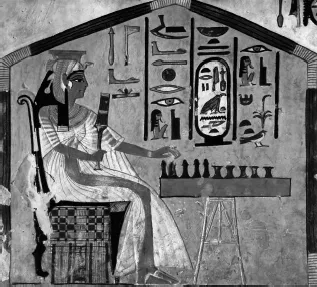
or in this representation of players:

The two games depicted here are Senet (on the left) and Mehen (on the right, which has been identified with a representation of the god of games, the serpent god). Senet, which is also a race game, has a strong religious relevance. In the game represented above it looks like there is only one player. However, it is life after death that is being gambled on against the god of the afterlife.
Another race game from ancient Egypt was Dogs and Jackals:

Once again we find almost independent courses. The players do not interact much during play. The lines connecting some pairs of holes (one “good” and one “bad”), to add drama to the game, are the first examples of such devices, well known in the popular Chutes & Ladders.
Nine Men Morris is a typical example of a family of alignment games. Probably known already in ancient times, only very recently (1996), through a very impressive computer analysis, it was found that, with perfect play, the game is a draw. It was very popular in western Europe in the Middle Ages.

Ludus Latrunculorum, the soldier game, was a favorite of the Roman army. It is a military strategy game, the board representing a battlefield, the pieces representing soldiers. We are not sure about the original rules. The board was rectangular with variable dimensions. Some were carved in stone and can still be found in several Roman monuments.

Alquerque, the grandfather of checkers, is also very old. We can find its vestiges in ancient monuments, raising difficult questions about its real age.
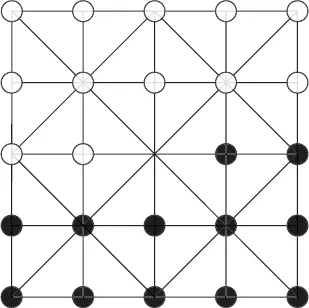
Archimedes (287-212 B.C.) described a geometric puzzle, the stomachion. It is a game similar to the tangram (a Chinese puzzle, still popular in the West), made up by fourteen plane shapes that can be assembled to make a square.
In the Sand Reckoner, Archimedes is believed to have described the combinatorial properties of stomachion, but that description has not survived.
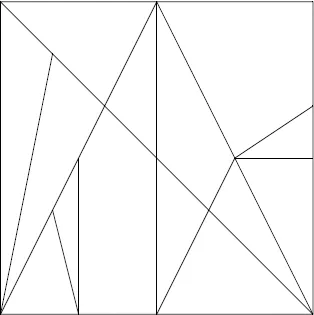
In the Middle Ages many board games were used. From the tenth century Ireland, the board of Fithcheall:
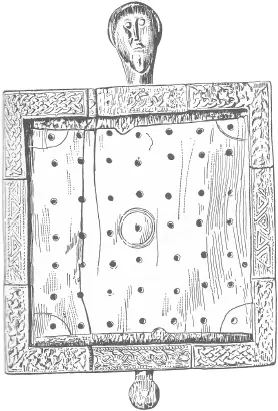
In this game, one of the two players takes the central square with his king, surrounding it with less valuable pieces. To win, this player needs to take his king to the periphery of the board. His adversary has more pieces, but no king. To win, this player needs to kill the king. The movements were orthogonal, like Chess rooks, and only custodian captures were permitted, surrounding the victim (see Glossary).
In the Middle Ages the erudite classes used to play several games. Some circulated only among universities, churches, and other educated places, where people could understand the complexity of the rules. One such example was Rithmomachia, also known as the Philosopher’s Game, which was associated with the teaching of Boethius’s Arithmetic for five hundred years.
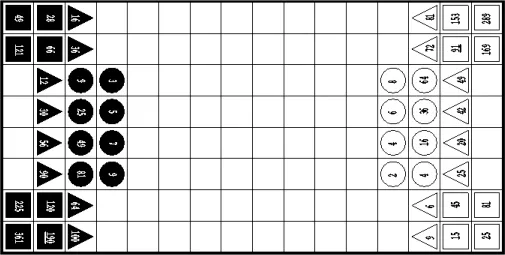
Rithmomachia was a pedagogical game, especially designed to grasp some numerical relations, such as progressions.
Besides its practical utility, arithmetical knowledge had religious and moral value. Accordingly, Rithmomachia had an important role in the education of the learned classes for a few centuries.
The movements depended on the shape of the pieces, and captures depended also on the numbers each piece displayed. Victory was accomplished by occupying some squares in the adversary’s half-board, with the corresponding numbers in special progressions.
Luca Pacioli, one of the leading mathematicians of the 15th century, was also a recreational mathematics fan. He wrote what is considered to be the first book on this subject. One of the puzzles described there is the now famous Chinese Rings:

The Irish mathematician Sir William Rowan Hamilton, in 1857, created a game, Icosian, which was a commercial flop. However, it was related with a very important concept in graph theory, Hamiltonian circuits.


One of the oldest games from which chess developed is Chaturanga, a popular game in India during the 6th century (played by four people).

Chess rules have varied a lot since then. In the Middle Ages, piece movement was sometimes decided by the use of dice. From the 16th century on, chess became more popular than Rithmomachia among educated classes in Europe. Today chess is played by millions, and the Philosopher’s Game is history.
Mathematical games are usually a favorite subject in books focused on the popularization of mathematics, and even in some pedagogical texts. However, math here is always apparent. In the games we call abstract the situation is different, the mathematical content is hidden. Playing the game is, in an abstract way, doing mathematics with the ludic side of each activity dominant.
G. H. Hardy, one of the most important mathematicians of the 20th century, said that the only difference between a chess problem and a mathematical theorem lies in their relevance. Abstract games and pure mathematics are the same… .
We believe that the practice of good games nurtures the intellect. We do not know how this mechanism actually works, but we believe that some good comes from playing interesting board games. Below we’ll try to pinpoint the qualities that make a game worth playing.
The State of the Art
In some human activities, as in science and philosophy, today’s production has attained such levels as to lead us to consider that we live in a golden age. The same is true for the market of games. In the past 25 years, board games have been invented at a pace never matched previously. In spite of the advent of computer games, new board games appear in quantity and quality, mainly in Germany, France and the USA. It is difficult, of course, to find a commercial success like Monopoly or Risk, but the German game from 1994, The Se...
Table of contents
- Cover
- Title Page
- Copyright Page
- Dedication
- Contents
- 1. The World of Games
- 2. Games for Two
- 3. Nim Games
- 4. Games for Three
- Glossary
- Bibliography